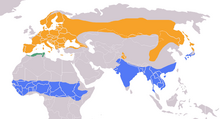Eurasian wryneck
| Eurasian wryneck | |
|---|---|
 |
|
| Scientific classification | |
| Kingdom: | Animalia |
| Phylum: | Chordata |
| Class: | Aves |
| Order: | Piciformes |
| Family: | Picidae |
| Subfamily: | Jynginae |
| Genus: | Jynx |
| Species: | J. torquilla |
| Binomial name | |
|
Jynx torquilla (Linnaeus, 1758) |
|
| Subspecies | |
|
|
|
 |
|
| Range map for Eurasian wryneck Summer Resident Winter |
|
The Eurasian wryneck (Jynx torquilla) is a species of wryneck in the woodpecker family. This species mainly breeds in temperate regions of Europe and Asia. Most populations are migratory, wintering in tropical Africa and in southern Asia from Iran to the Indian Subcontinent, but some are resident in northwestern Africa. It is a bird of open countryside, woodland and orchards.
Eurasian wrynecks measure about 16.5 cm (6.5 in) in length and have bills shorter and less dagger-like than those of other woodpeckers. Their upperparts are barred and mottled in shades of pale brown with rufous and blackish bars and wider black streaks. Their underparts are cream speckled and spotted with brown. Their chief prey is ants and other insects, which they find in decaying wood or on the ground. The eggs are white as is the case with many birds that nest in holes and a clutch of seven to ten eggs is laid during May and June.
These birds get their English name from their ability to turn their heads through almost 180 degrees. When disturbed at the nest, they use this snake-like head twisting and hissing as a threat display. This odd behaviour led to their use in witchcraft, hence to put a "jinx" on someone.
The Eurasian wryneck was first described by Carl Linnaeus in the tenth edition of his Systema Naturae in 1758. The type species came from Sweden.
The genus name Jynx is from the Ancient Greek name for this bird, iunx. The specific torquilla is Medieval Latin derived from torquere, to twist, referring to the strange snake-head movements. The bird was used as a charm to bring back an errant lover, the bird being tied to a piece of string and whirled around. The English "wryneck" refers to the same twisting movement and was first recorded in 1585.
The family Picidae has four subfamilies, the Picinae (woodpeckers), the Picumninae (piculets), the Jynginae (wrynecks) and the monotypic Nesoctitinae (Antillean piculet). Based on morphology and behaviour, the Picumninae was considered to be the sister clade of the Picinae. This has now been confirmed by phylogenetic analysis and the Jynginae are placed basal to the Picinae, Nesoctitinae and Picumninae.
...
Wikipedia

